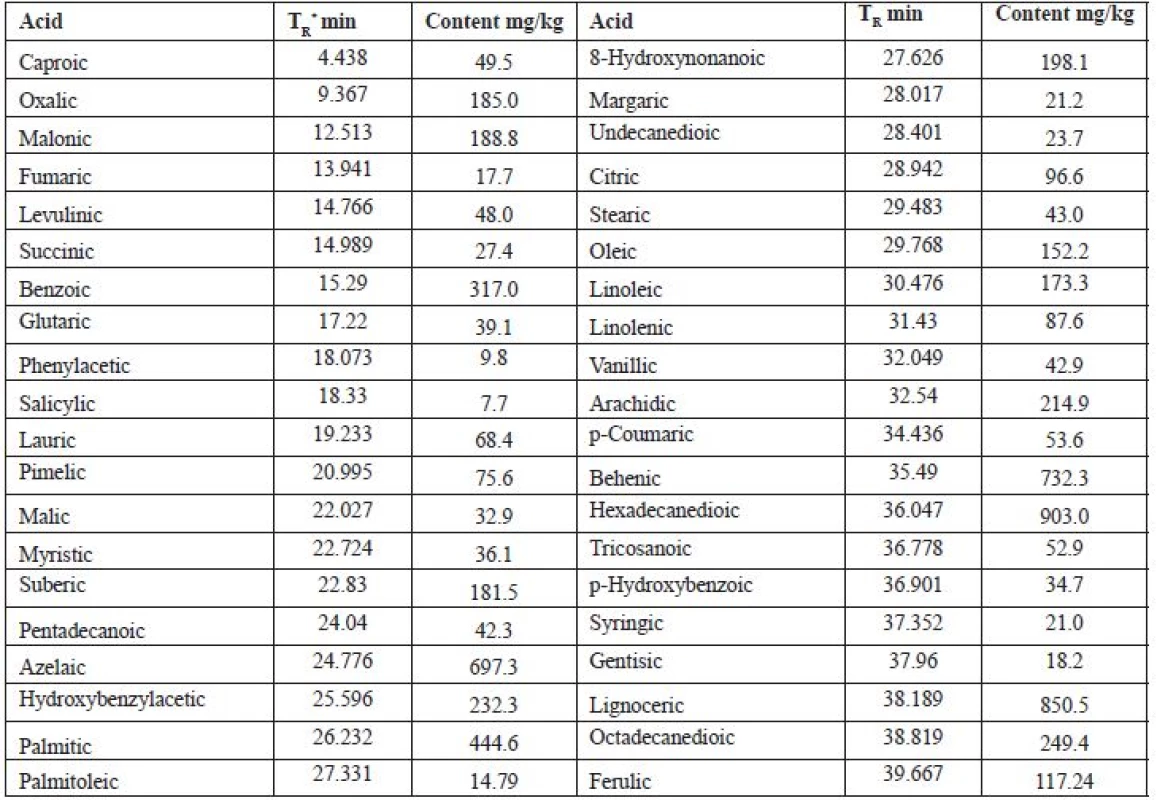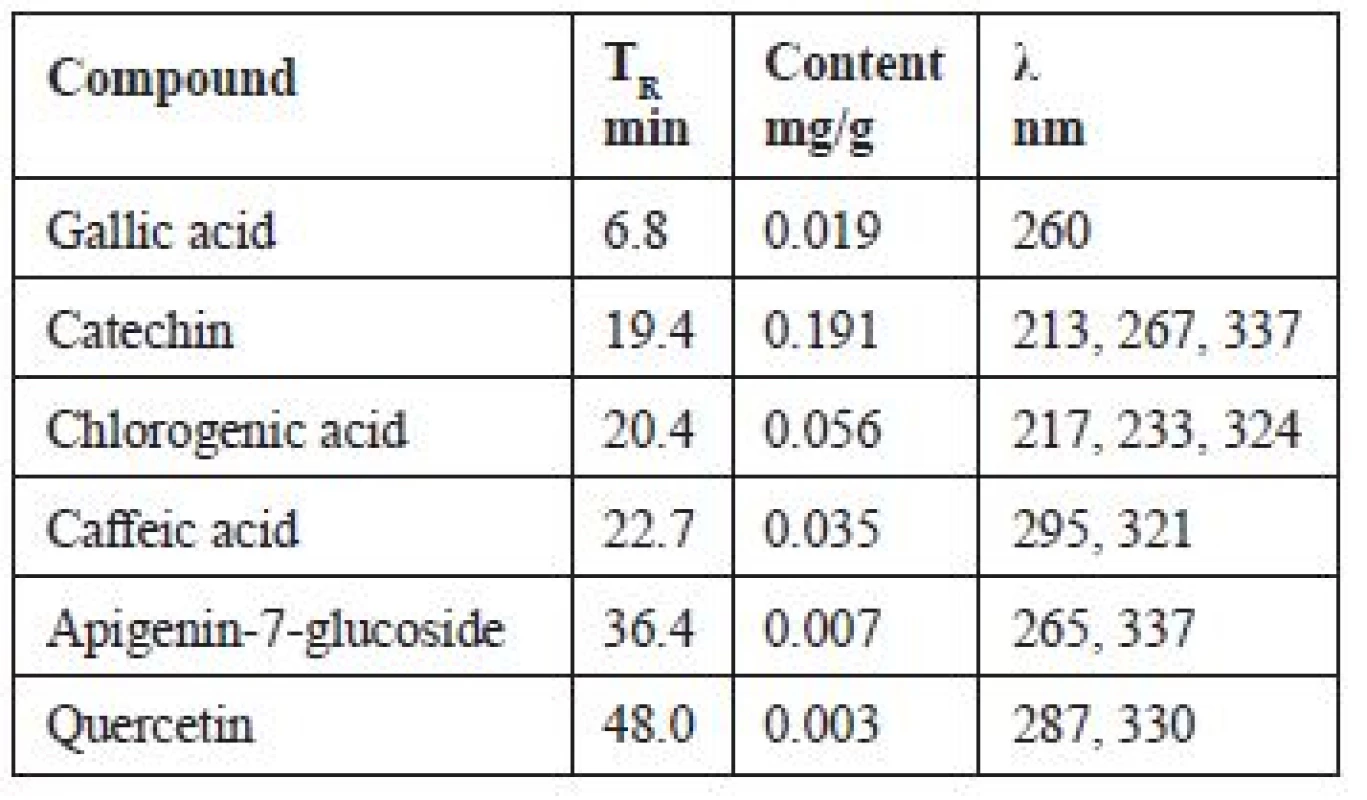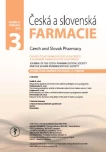-
Články
Top novinky
Reklama- Vzdělávání
- Časopisy
Top články
Nové číslo
- Témata
Top novinky
Reklama- Kongresy
- Videa
- Podcasty
Nové podcasty
Reklama- Kariéra
Doporučené pozice
Reklama- Praxe
Top novinky
ReklamaVýzkum chemického složení kůry Sorbus aucuparia
Výzkum chemického složení kůry Sorbus aucuparia
V extraktu kůry Sorbus aucuparia byl stanoven metodou GC-MS kvantitativní obsah 40 karboxylových kyselin s prevalencí hexadekandiové, lignocerové, behenové, azelaové, palmitové a benzoové kyseliny, a 39 složek silice. V etanolickém extraktu kůry Sorbus aucuparia byl metodou HPLC kvantitativně stanoven obsah šesti fenolických sloučenin, tj. kyseliny chlorogenové, kávové a galové, katechinu, kvercetinu a apigenin-7-glukosidu.
Klíčová slova:
Sorbus aucuparia • kůra • karboxylové kyseliny • fenolické sloučeniny • silice • GC-MS • HPLC
Authors: Elena Krivoruchko; Alexander Markin; Victoria Samoilova; Tetiana Ilina; Oleh Koshovyi
Published in the journal: Čes. slov. Farm., 2018; 67, 113-115
Category: Krátká sdělení
Summary
The quantitative contents of 40 carboxylic acids, with the prevalence of hexadecanedioic, lignocerinic, behenic, azelaic, palmitic and benzoic acids, and 39 components of essential oil were determined in the extracts of the bark of Sorbus aucuparia by the GC-MS method. The quantitative contents of 6 phenolic compounds, i.e., chlorogenic, caffeic, and gallic acids, catechin, quercetin, and apigenin-7-glucoside were determined by the HPLC method in the ethanolic extract of the bark of Sorbus aucuparia.
Key words:
Sorbus aucuparia • bark • carboxylic acids • phenolic compounds • essential oil, GC-MS, HPLC
Introduction
Sorbus aucuparia (European mountain ash, Rowan tree) from the family Rosaceae is widely spread throughout Europe as an ornamental and medicinal plant. Fruits and leaves of S. aucuparia contain vitamins, carbohydrates, organic acids, phenolic compounds and terpenoids, which are known to have an antioxidant, antiscorbutic, diuretic, choleretic, antidiabetic, laxative, or hemostatic effect1–6). Yet, the bark of S. aucuparia has not been given enough attention by researchers. From scattered research it is known that extracts from the bark of Sorbus decora and Sorbus americana have an antidiabetic effect, whereas extracts from the bark of Sorbus commixta have a hepatoprotective effect7–9). The objective of this work was to study carboxylic acids, essential oil and phenolic compounds of the bark of Sorbus aucuparia.
Experimental part
The bark of the branches of S. aucuparia was harvested for analysis in April 2017 in the Botanic Garden of the National University of Pharmacy.
The identification and determination of carboxylic acids in the bark of S. aucuparia was carried out by the HPLC method on an Agilent Technologies 6890 chromatograph with a mass spectrometric detector, 5973N. The sample for the analysis was prepared according to the previously described procedure6). We used the NIST05 and WILEY 2007 mass spectra libraries with a total number of spectra exceeding 470000, in combination with the AMDIS and NIST programs for identification of the components.
Essential oil from the bark of S. aucuparia was obtained by the hydrodistillation method. The determination of essential oil components was carried out on an Agilent Technologies 6890 chromatograph with a 5973N mass spectrometric detector. The procedure of obtaining essential oil and the chromatographic conditions were described earlier10).
The research of phenolic compounds in a 70 % ethanolic extract of the bark of S. aucuparia was carried out by the HPLC method. The Shimadzu LC-20 Prominence module system, equipped with a LC-20AD quaternary pump, a СТО-20А column oven, a SIL-20A autosampler, a SPD-M20A diode array detector and a LC-20 chemstation, was used for data analysis. The chromatographic conditions were described previously11). The identification of phenolic compounds in the ethanolic extract of the bark of S. aucuparia was carried out against the retention time of standards and spectral characteristics.
The results of the research are presented in Tables 1, 2, and 3.
Tab. 1. Carboxylic acids of bark of Sorbus aucuparia 
TR* – retention time of acid methyl ester Tab. 2. Main components of essential oil of bark of Sorbus aucuparia 
Tab. 3. Phenolic compounds of ethanolic extract of bark of Sorbus aucuparia 
Results and discussion
We determined the contents of 40 carboxylic acids in the bark of S. aucuparia by the GC-MS method as 10 aromatic, 12 dibasic, 1 tribasic, and 17 fatty acids; predominantly hexadecanedioic (903.0 mg/kg), lignoceric (850.5 mg/kg), behenic (732.3 mg/kg), azelaic (697.3 mg/kg), palmitic (444.6 mg/kg) and benzoic acid (317.0 mg/kg). Identified in the essential oil of the bark of S. aucuparia also were 39 components, namely 1 triterpene, 8 aldehydes, 3 alcohols, 3 ketones, 12 fatty acids and 12 alkanes. The oil contains a significant amount of the precursor of numerous triterpenes, i.e., squalene (1283.52 mg/kg). Most identified aldehydes, alcohols and ketones are fragrant substances imparting odour to the raw materials. Identified by the HPLC method also were 6 phenolic compounds in the ethanolic extract of the bark of S. aucuparia. Also determined were 3 phenolic acids, i.e., chlorogenic, caffeic and gallic, and 3 flavonoids, i.e., catechin, quercetin and apigenin-7-glucoside, with chlorogenic acid (0.056 mg/g) prevailing among the acids in the raw material and catechin (0.191 mg/g) prevailing among the flavonoids. Previously, chlorogenic and caffeic acids, catechin and quercetin were found in the leaves and fruit of S. aucuparia, and gallic acid in the fruit of S. aucuparia 2–5). Apigenin-7-glucoside was not identified in S. aucuparia, but it was identified, among the species of the genus Sorbus, in the leaves of S. torminalis12). The results of the present research testify for the importance of further phytochemical and pharmacological studies in the bark of S. aucuparia.
Conflicts of interest: none.
Received: April 18, 2018
Accepted: July 23, 2018
Ass. Prof. Elena V. Krivoruchko, D.Sc. (∗) • V. A. Samoilova • T. V. Ilina • O. M. Koshovyi
National University of Pharmacy
4-Valentynivska str., 61168 Kharkiv, Ukraine
e-mail: evphyto@gmail.com
A. Markin
Pharmacognosy Department, National University of Pharmacy, Kharkiv, Ukraine
Zdroje
1. Khare C. P. Indian Medicinal Plants. An Illustrated Dictionary. Springer India 2007; 618–619.
2. Raudonis R., Raudone L., Gaivelyte K., Viskelis P., Janulis V. Phenolic and antioxidant profiles of rowan (Sorbus L.) fruits. Nat. Prod. Res. 2014; 28(16), 1231–1240.
3. Olszewska M. A., Michel P. Antioxidant activity of inflorescences, leaves and fruits of three Sorbus species in relation to their polyphenolic composition. Nat. Prod. Res. 2009; 23(16), 1507–1521.
4. Olszewska M. A. Variation in the phenolic content and in vitro antioxidant activity of Sorbus aucuparia leaf extracts during vegetation. Acta Pol. Pharm. 2011; 68(6), 937–944.
5. Olszewska M. A., Presler A., Michel P. Profiling of phenolic compounds and antioxidant activity of dry extracts from the selected Sorbus species. Molecules 2012; 17(3), 3093–3113.
6. Krivoruchko E. V., Andrushchenko О. А., Kononenko A. V. Carboxylic acids from Sorbus aucuparia and Sorbus aria. Chem. Nat. Compd. 2013; 49(4), 742–743.
7. Guerrero-Analco J. A., Martineau L., Saleem A., Madiraju P., Muhammad A., Durst T., Haddad P., Arnason J. T. Bioassay-guided isolation of the antidiabetic principle from Sorbus decora (Rosaceae) used traditionally by the Eeyou Istchee Cree First Nations. J. Nat. Prod. 2010; 73(9), 1519–1523.
8. Lee S. O., Lee H. W., Lee I. S., Im H. G. The pharmacological potential of Sorbus commixta cortex on blood alcohol concentration and hepatic lipid peroxidation in acute alcohol-treated rats. J. Pharm. Pharmacol. 2006; 58(5), 685–693.
9. Saleem A., Liu R., Guerrero-Analco J. A., Bailie A., Foster B., Cuerrier A., Johns T., Haddad P. S., Arnason J. T. An HPLC-ELSD Method for the Determination of Triterpenes in Sorbus decora and Sorbus americana Bark Used by the Eeyou Istchee Cree First Nation. Planta Med. 2016; 82(14), 1302–1307.
10. Osmachko A., Kovaleva A., Goryacha O., Ili’ina T. Сomponents of essential oil of Veronica longifolia L. leaves and flovers. The Pharma Innovation Journal 2014; 3(1), 1–6.
11. Golembiovska O. I. Simultaneous determination of flavonoids and phenolic acids in different parts of Prunella vulgaris L. by high-performance liquid chromatography with photodiode array detection. Int. J. Pharmacog. Phytochem. 2014; 29(1), 1248–1255.
12. Tsitsa-Tzardi E., Loukis A., Philianos S. Constituents of Sorbus torminalis leaves. Fitoterapia 1992; 63(2), 189–190.
Štítky
Farmacie Farmakologie
Článek vyšel v časopiseČeská a slovenská farmacie
Nejčtenější tento týden
2018 Číslo 3- Pomůže AI k rychlejšímu vývoji antibiotik na kapavku a MRSA?
- Ukažte mi, jak kašlete, a já vám řeknu, co vám je
- Biomarker NT-proBNP má v praxi široké využití. Usnadněte si jeho vyšetření POCT analyzátorem Afias 1
-
Všechny články tohoto čísla
- Imunomodulační aktivita etanolových extraktů z Galium verum L. herb.
- Biosurfactants and their role in the inhibition of the biofilmforming pathogens
- Výzkum chemického složení kůry Sorbus aucuparia
- Pharmacy, pharmacists and drugs in the Terezín ghetto
-
XLIV. lekárnické dni, Lekárnickej sekcie SFS, o. z., SLS
Donovaly, 21. až 23. júna 2018 - Výstava léčivých rostlin v Brně
- Remko M. Zápisky chemika. Bratislava Remedika 2018, 368 s. ISBN 978-80-972954-0-0
- Inflammatory bowel disease: factors involved in pathogenesis
- Česká a slovenská farmacie
- Archiv čísel
- Aktuální číslo
- Informace o časopisu
Nejčtenější v tomto čísle- Inflammatory bowel disease: factors involved in pathogenesis
- Pharmacy, pharmacists and drugs in the Terezín ghetto
- Biosurfactants and their role in the inhibition of the biofilmforming pathogens
- Imunomodulační aktivita etanolových extraktů z Galium verum L. herb.
Kurzy
Zvyšte si kvalifikaci online z pohodlí domova
Autoři: prof. MUDr. Vladimír Palička, CSc., Dr.h.c., doc. MUDr. Václav Vyskočil, Ph.D., MUDr. Petr Kasalický, CSc., MUDr. Jan Rosa, Ing. Pavel Havlík, Ing. Jan Adam, Hana Hejnová, DiS., Jana Křenková
Autoři: MUDr. Irena Krčmová, CSc.
Autoři: MDDr. Eleonóra Ivančová, PhD., MHA
Autoři: prof. MUDr. Eva Kubala Havrdová, DrSc.
Všechny kurzyPřihlášení#ADS_BOTTOM_SCRIPTS#Zapomenuté hesloZadejte e-mailovou adresu, se kterou jste vytvářel(a) účet, budou Vám na ni zaslány informace k nastavení nového hesla.
- Vzdělávání



